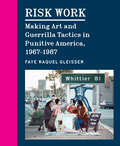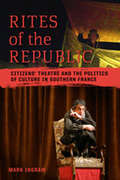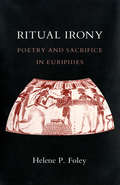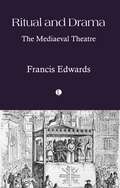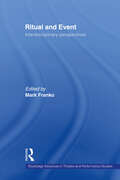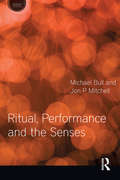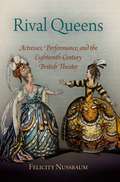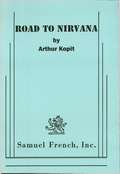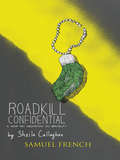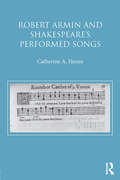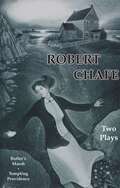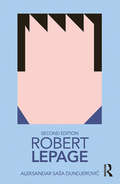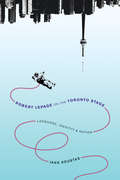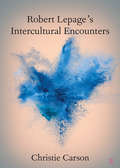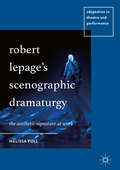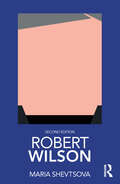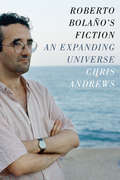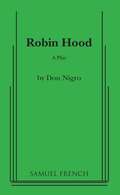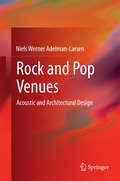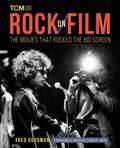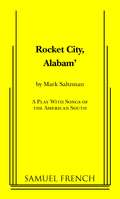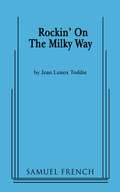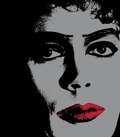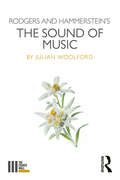- Table View
- List View
Risk Work: Making Art and Guerrilla Tactics in Punitive America, 1967–1987
by Faye Raquel GleisserHow artists in the US starting in the 1960s came to use guerrilla tactics in performance and conceptual art, maneuvering policing, racism, and surveillance. As US news covered anticolonialist resistance abroad and urban rebellions at home, and as politicians mobilized the perceived threat of “guerrilla warfare” to justify increased police presence nationwide, artists across the country began adopting guerrilla tactics in performance and conceptual art. Risk Work tells the story of how artists’ experimentation with physical and psychological interference from the late 1960s through the late 1980s reveals the complex and enduring relationship between contemporary art, state power, and policing. Focusing on instances of arrest or potential arrest in art by Chris Burden, Adrian Piper, Jean Toche, Tehching Hsieh, Pope.L, the Guerrilla Girls, Asco, and PESTS, Faye Raquel Gleisser analyzes the gendered, sexualized, and racial politics of risk-taking that are overlooked in prevailing, white-centered narratives of American art. Drawing on art history and sociology as well as performance, prison, and Black studies, Gleisser argues that artists’ anticipation of state-sanctioned violence invokes the concept of “punitive literacy,” a collectively formed understanding of how to protect oneself and others in a carceral society.
Rites of the Republic: Citizens' Theatre And The Politics Of Culture In Southern France (Teaching Culture: Utp Ethnographies For The Classroom Ser.)
by Mark IngramIn this fascinating exploration of citizenship and the politics of culture in contemporary France, Ingram examines two theatre troupes in Provence: one based in a small town in the rural part of the Vaucluse region, and the other an urban project in Marseille, France's most culturally diverse city. Both troupes are committed to explicitly civic goals in the tradition of citizens' theatre. Focusing on the personal stories of the theatre artists in these two troupes, and the continuities between their narratives, their performances, and the national discourse directed by the Ministry of Culture, Ingram examines the ways in which these artists interpret universalistic ideals underlying both art and the Republic in their theatrical work. In the process he charts the evolution of new models for society and citizenship in a rapidly changing France.
Ritual Irony: Poetry and Sacrifice in Euripides
by Helene P. FoleyRitual Irony is a critical study of four problematic later plays of Euripides: the Iphigenia in Aulis, the Phoenissae, the Heracles, and the Bacchae.Examining Euripides' representation of sacrificial ritual against the background of late fifth-century Athens, Helene P. Foley shows that each of these plays confronts directly the difficulty of making an archaic poetic tradition relevant to a democratic society. She explores the important mediating role played by choral poetry and ritual in the plays, asserting that Euripides' sacrificial metaphors and ritual performances link an anachronistic mythic ideal with a world dominated by "chance" or an incomprehensible divinity.Foley utilizes the ideas and methodology of contemporary literary theory and symbolic anthropology, addressing issues central to the emerging dialogue between the two fields. Her conclusions have important implications for the study of Greek tragedy as a whole and for our understanding of Euripides' tragic irony, his conception of religion, and the role of his choral odes.Assuming no specialized knowledge, Ritual Irony is aimed at all readers of Euripidean tragedy. It will prove particularly valuable to students and scholars of classics, comparative literature, and symbolic anthropology.
Ritual and Drama: The Mediaeval Theatre
by Francis EdwardsIn Ritual and Drama: The Mediaeval Theatre, Francis Edwards reveals that ritual forms the basis of all popular theatrical entertainment, the root from which dramatic art has grown. Covering the period from the tenth to the fifteenth centuries, Edwards focusses on the audience impact rather than the artistic qualities of the mediaeval plays, devoting much of his attention to the emotional effect of religious and dramatic ritual on the spectator. Illuminating the impact of Christian rituals, liturgy, and stories, Edwards draws illustrative parallels between mediaeval and modern states of mind. Ritual and Drama describes the growth of the dramatic idea, the styles of presentation of the mystery cycles, and the evolution of the morality play, presenting in straightforward terms a theme fundamental to our understanding of mediaeval dramatic art.
Ritual and Event: Interdisciplinary Perspectives (Routledge Advances in Theatre & Performance Studies)
by Mark FrankoRitual today can be encountered in the midst of catastrophic and transforming events. This collection reassesses and revises traditionally understood relationships between ritual and politics, ritual and everyday life, ritual and art making, and ritual and disaster. The methodologies as well as the subject matter are interdisciplinary: they range from the anthropological to the art and dance historical, from the theatrical and literary to the linguistic, philosophical, and psychoanalytic. It will be a valuable tool for scholars of Theater and Performance Studies, as well as Anthropology, Art, and History.
Ritual, Performance and the Senses (Sensory Studies)
by Michael BullRitual has long been a central concept in anthropological theories of religious transmission. Ritual, Performance and the Senses offers a new understanding of how ritual enables religious representations – ideas, beliefs, values – to be shared among participants. Focusing on the body and the experiential nature of ritual, the book brings together insights from three distinct areas of study: cognitive/neuroanthropology, performance studies and the anthropology of the senses. Eight chapters by scholars from each of these sub-disciplines investigate different aspects of embodied religious practice, ranging from philosophical discussions of belief to explorations of the biological processes taking place in the brain itself. Case studies range from miracles and visionary activity in Catholic Malta to meditative practices in theatrical performance and include three pilgrimage sites: the Church of the Holy Sepulchre in Jerusalem, the festival of Ramlila in Ramnagar, India and the mountain shrine of the Lord of the Shiny Snow in Andean Peru.Understanding ritual allows us to understand processes at the very centre of human social life and humanity itself, making this an invaluable text for students and scholars in anthropology, cognitive science, performance studies and religious studies.
Rival Queens
by Felicity NussbaumIn eighteenth-century England, actresses were frequently dismissed as mere prostitutes trading on their sexual power rather than their talents. Yet they were, Felicity Nussbaum argues, central to the success of a newly commercial theater. Urban, recently moneyed, and thoroughly engaged with their audiences, celebrated actresses were among the first women to achieve social mobility, cultural authority, and financial independence. In fact, Nussbaum contends, the eighteenth century might well be called the "age of the actress" in the British theater, given women's influence on the dramatic repertory and, through it, on the definition of femininity.Treating individual star actresses who helped spark a cult of celebrity--especially Anne Oldfield, Susannah Cibber, Catherine Clive, Margaret Woffington, Frances Abington, and George Anne Bellamy--Rival Queens reveals the way these women animated issues of national identity, property, patronage, and fashion in the context of their dramatic performances. Actresses intentionally heightened their commercial appeal by catapulting the rivalries among themselves to center stage. They also boldly rivaled in importance the actor-managers who have long dominated eighteenth-century theater history and criticism. Felicity Nussbaum combines an emphasis on the celebrated actresses themselves with close analysis of their diverse roles in works by major playwrights, including George Farquhar, Nicholas Rowe, Colley Cibber, Arthur Murphy, David Garrick, Isaac Bickerstaff, and Richard Sheridan. Hers is a comprehensive and original argument about the importance of actresses as the first modern subjects, actively shaping their public identities to make themselves into celebrated properties.
Road to Nirvana
by Arthur KopitBlack Comedy / 2m, 2f / 2 Exteriors / Ex movie moguls on the skids reunite to co produce the big one an autobiographical screenplay by the world's hottest female rock star. She will even star as herself if she can find producers willing to meet her extraordinary terms.
Roadkill Confidential
by Sheila CallaghanThriller/Mystery / 3m, 2f / A possibly rogue g-man stalks a stalled-out artist with a suspicious affinity for accident victims. Traps are set, traps are sprung, and everyone gets caught. Roadkill Confidential tackles, with style, humor and high theatricality, mediated violence and the numbness it produces, and, whether in art or in global politics, the ends can justify the means. / "Roadkill Confidential, a new work by Sheila Callaghan, is intriguing to watch...it's a sick sitcom, it's a thriller, it's a parody, it's a commentary on the art world, it's a -- this one's borrowed from the script's title page - 'noir-ish meditation on brutality.' - The New York Times
Robert Armin and Shakespeare's Performed Songs
by Catherine A. HenzeAfter Robert Armin joined the Chamberlain's Men, singing in Shakespeare's dramas catapulted from 1.25 songs and 9.95 lines of singing per play to 3.44 songs and 29.75 lines of singing, a virtually unnoticed phenomenon. In addition, many of the songs became seemingly improvisatory—similar to Armin's personal style as an author and solo comedian. In order to study Armin's collaborative impact, this interdisciplinary book investigates the songs that have Renaissance music that could have been heard on Shakespeare's stage. They occur in some of Shakespeare's most famous plays, including Much Ado About Nothing, Twelfth Night, Hamlet, and The Tempest. In fact, Shakespeare's plays, as we have them, are not complete. They are missing the music that could have accompanied the plays’ songs. Significantly, Renaissance vocal music, far beyond just providing entertainment, was believed to alter the bodies and souls of both performers and auditors to agree with its characteristics, directly inciting passions from love to melancholy. By collaborating with early modern music editor and performing artist Lawrence Lipnik, Catherine Henze is able to provide new performance editions of seventeen songs, including spoken interruptions and cuts and rearrangement of the music to accommodate the dramatist's words. Next, Henze analyzes the complete songs, words and music, according to Renaissance literary and music primary sources, and applies the new information to interpretations of characters and scenes, frequently challenging commonly held literary assessments. The book is organized according to Armin's involvement with the plays, before, during, and after the comic actor joined Shakespeare's company. It offers readers the tools to interpret not only these songs, but also vocal music in dramas by other Renaissance playwrights. Moreover, Robert Armin and Shakespeare's Performed Songs, written with non-specialized terminology, provides a gateway to new areas of research and interpretation in an increasingly significant interdisciplinary field for all interested in Shakespeare and early modern drama.
Robert Chafe: Butler's Marsh and Tempting Providence
by Robert ChafeButler's Marsh Thirty years ago Nora's mother disappeared into the small, dense forest of Butler's Marsh. She emerged three days later, covered in blood, badly shaken, and completely silent about what had happened. Having never been offered a suitable explanation, and now finding herself at her own moment of crisis, Nora ventures to Newfoundland for the first time to explore Butler's Marsh for herself. She is accompanied by her partner Tim, who, while less than helpful, is nevertheless adamant that she not be left alone. But as Nora's night in Butler's Marsh unfolds, and Tim's good humour wanes, the primary question of what happened to her mother quickly becomes less troubling than another; with whom exactly is she lost in the woods? Tempting Providence In 1921 Myra Grimsley signed a two-year contract and boarded a steamship from London, England, to St. John's, Newfoundland. Her charge: to serve as the sole health-care provider for three hundred miles of the sparsely settled coast of Newfoundland's Great Northern Peninsula. By the time her contract ran out two years later, Myra was married to local Angus Bennett, and had given birth to their first child, Grace. Based on the true story of Nurse Myra Bennett, Tempting Providence is a play about duty and sadness, love and change. Four strong characters drive this no-frills drama about a young British nurse who only signed on for two years, and the local man for whom she stayed for seventy.
Robert Lepage (Routledge Performance Practitioners)
by Aleksandar Saša DundjerovićRobert Lepage is one of Canada’s foremost theatre authors and directors. His company, Ex Machina, has toured to international acclaim and he has lent his talents to areas as diverse as opera, film, solo performance and installation art. His most celebrated work blends acute personal narratives with bold global themes through collaborative and multimedia theatricality. This book is the first to combine: • An overview of the key phases in Lepage’s life and career • An examination of the issues and questions pertinent to his work • A discussion of The Dragons’ Trilogy as a paradigm of his working methods • A variety of practical exercises designed to give an insight into Lepage’s creative process. As a first step towards critical understanding, and as an initial exploration before going on to further, primary research, Routledge Performance Practitioners are of unbeatable value for today’s student.
Robert Lepage on the Toronto Stage: Language, Identity, Nation
by Jane KoustasA leader in theatre production for a global community, Robert Lepage - actor, cineaste, and director - revolutionized the Toronto theatre scene from the 1980s onwards by challenging conventional notions of language, identity, and national belonging. Exploring Lepage's twenty-five-year history on the Toronto stage, Jane Koustas analyzes his importance in the Canadian and international theatre scenes. Outlining the reasons behind Lepage's success in Toronto, Koustas skilfully engages with a wide range of journalistic and scholarly texts, moving between French and English critical reception of his work. For Lepage, Toronto offered the best of both worlds: he could remain an ardent Quebecer while being welcomed as a fellow Canadian. Lepage, raised in a bilingual family, brought to his Toronto productions an understanding of English and Canadian culture that resisted presenting French against English and the rest of Canada versus Quebec. Instead, he took Toronto audiences on a global theatre voyage that transformed traditional geopolitical, cultural, and linguistic boundaries and questioned identity. Investigating the relationship between Quebec's master dramaturge and Toronto, a burgeoning cosmopolitan city determined to be a global cultural capital, Robert Lepage on the Toronto Stage analyzes the success of one of the few Québécois artists to have achieved fame in English Canada.
Robert Lepage on the Toronto Stage: Language, Identity, Nation
by Jane KoustasA leader in theatre production for a global community, Robert Lepage - actor, cineaste, and director - revolutionized the Toronto theatre scene from the 1980s onwards by challenging conventional notions of language, identity, and national belonging. Exploring Lepage’s twenty-five-year history on the Toronto stage, Jane Koustas analyzes his importance in the Canadian and international theatre scenes. Outlining the reasons behind Lepage’s success in Toronto, Koustas skilfully engages with a wide range of journalistic and scholarly texts, moving between French and English critical reception of his work. For Lepage, Toronto offered the best of both worlds: he could remain an ardent Quebecer while being welcomed as a fellow Canadian. Lepage, raised in a bilingual family, brought to his Toronto productions an understanding of English and Canadian culture that resisted presenting French against English and the rest of Canada versus Quebec. Instead, he took Toronto audiences on a global theatre voyage that transformed traditional geopolitical, cultural, and linguistic boundaries and questioned identity. Investigating the relationship between Quebec’s master dramaturge and Toronto, a burgeoning cosmopolitan city determined to be a global cultural capital, Robert Lepage on the Toronto Stage analyzes the success of one of the few Québécois artists to have achieved fame in English Canada.
Robert Lepage's Intercultural Encounters (Elements in Shakespeare Performance)
by Christie CarsonThis study returns to the origins of Robert Lepage's directorial work and his first cross-cultural interaction with a Shakespearean text to provide some background for his later work. This early work is situated within the political and social context of Quebec and Canada in the 1980s. Constitutional wrangling and government policies of bilingualism, biculturalism and multiculturalism all had a profound impact on this director, helping to forge his priorities and working methods. In 2018 two of Lepage's productions were cancelled due to concerns about cultural appropriation. Lepage responded by stating his view that the artist is as above the concerns of political correctness. While this approach was deemed acceptable in the 1980s, this study looks at the dangers posed by approaching cross-cultural creation from this standpoint in the 21st century.
Robert Lepage’s Scenographic Dramaturgy: The Aesthetic Signature at Work (Adaptation in Theatre and Performance)
by Melissa PollThis book theorizes auteur Robert Lepage’s scenography-based approach to adapting canonical texts. Lepage’s technique is defined here as ‘scenographic dramaturgy’, a process and product that de-privileges dramatic text and relies instead on evocative, visual performance and intercultural collaboration to re-envision extant plays and operas. Following a detailed analysis of Lepage’s adaptive process and its place in the continuum of scenic writing and auteur theatre, this book features four case studies charting the role of Lepage’s scenographic dramaturgy in re-‘writing’ extant texts, including Shakespeare’s Tempest on Huron-Wendat territory, Stravinsky’s Nightingale in a twenty-seven ton pool, and Wagner’s Ring cycle via the infamous, sixteen-million-dollar Metropolitan Opera production. The final case study offers the first interrogation of Lepage’s twenty-first century ‘auto-adaptations’ of his own seminal texts, The Dragons’ Trilogy and Needles & Opium. Though aimed at academic readers, this book will also appeal to practitioners given its focus on performance-making, adaptation and intercultural collaboration.
Robert Wilson (Routledge Performance Practitioners)
by Maria ShevtsovaRobert Wilson is an American–European director who is also a performer, installation artist, writer, designer of light and much more besides – a crossover polymath who dissolves both generic and geographical boundaries and is a precursor of globalisation in the arts. This second edition of Robert Wilson combines: an analysis of his main productions, situated in their American and European socio-cultural and political contexts a focused, detailed study of Wilson’s pathbreaking Einstein on the Beach a study of Pushkin's Fairy Tales as the foremost example of his folk-rock music theatre in the twenty-first century an exploration of his ‘visual book’, workshop and rehearsal methods, and collaborative procedures a study of his aesthetic principles and the elements of composition that distinguish his directorial approach a series of practical exercises for students and practitioners highlighting Wilson’s technique. As a first step towards critical understanding, and as an initial exploration before going on to further, primary research, Routledge Performance Practitioners offer unbeatable value for today’s student.
Roberto Bolaño's Fiction
by Chris AndrewsSince the publication of The Savage Detectives in 2007, the work of Roberto Bolaño (1953--2003) has achieved an acclaim rarely enjoyed in contemporary fiction. Chris Andrews, a leading translator of Bolaño's work into English, explores the singular achievements of the author's oeuvre, engaging with its distinct style and key thematic concerns, incorporating his novels and stories into the larger history of Latin American and global literary fiction.Andrews provides new readings and interpretations of Bolaño's novels, including 2666, The Savage Detectives, and By Night in Chile while at the same time examining the ideas and narrative strategies that unify his work. He begins with a consideration of the reception of Bolaño's fiction in English translation, examining the reasons behind its popularity. Subsequent chapters explore aspects of Bolaño's fictional universe and the political, ethical, and aesthetic values that shape it. Bolaño emerges as the inventor of a prodigiously effective "fiction-making system," a subtle handler of suspense, a chronicler of aimlessness, a celebrator of courage, an anatomist of evil, and a proponent of youthful openness. Written in a clear and engaging style, Roberto's Bolano's Fiction offers an invaluable understanding of one of the most important authors of the last thirty years.
Robin Hood
by Don NigroComedy Characters: 14 male, 8 female (more if desired.) . Unit set.. In a land where the rich get richer and the poor are starving, Prince John wants to cut down Sherwood Forest to put up an arms manufactory, a slaughterhouse and a tennis court for the well to do. This bawdy epic unites elements of wild farce and ancient mythologies with an environmentalist assault on the arrogance of wealth and power in the face of poverty and hunger using feeble and insane jesters, a demonic snake oil salesman, a corrupt and lascivious court, a singer of eerie ballads, a gluttonous lusty friar and a world of other grotesque characters out of a Brueghel painting. Maid Marian loses her clothes and her illusions among the poor and Robin tries to avoid murder and elude the Dark Monk of the Wood who is Death and perhaps something more.
Rock and Pop Venues
by Niels Werner Adelman-LarsenPopular music plays a substantial role in most people's life. The demand and financial revenue of Rock and Pop concerts is large and still increasing with the decreased revenue on recorded music. Based on the first ever scientific investigations on recommendable acoustics for amplified music conducted by the author, this book sets forward precise guidelines for acoustical engineers to optimize the acoustics in existing or future halls for amplified music. Gives precise guidelines on how to design the acoustics in venues that present amplified music Debates essential construction details, including placement of sound system and use of possible building materials, in the architectural design of new venues or the renovation of old ones Portrays 75 well-known European Rock & Pop venues, their architecture and acoustic properties. 20 venues were rated for their acoustics by music professionals leading to an easy-to-use assessment methodology "Acoustics are important within pop and rock venues to ensure a great experience for audiences and performers. This book fills an important gap of knowledge on the acoustics of venues. It will be of value to sound engineers as well as building owners and operators and building design professionals". Rob Harris, Arup Acoustics "With this book, many future amplified music concerts will sound better, for the joy of audiences and musicians alike. This enormous work demonstrates a rare degree of passion and insight, from the hand of the key researcher in the field". Dr. Per V. Brüel
Rock on Film: The Movies That Rocked the Big Screen (Turner Classic Movies)
by Fred GoodmanFor rock music and film buffs alike, this is the ultimate guide exploring the electrifying, entertaining, and often daring marriage of rock & roll and cinema.When the use of Bill Haley&’s &“Rock Around the Clock&” turned 1955&’s Blackboard Jungle into a teen sensation and a box-office smash, it proved the opening shot in a cinematic and cultural revolution. Starting with Elvis Presley and the teensploitation films of the &’50s and &’60s, in Rock on Film award-winning author and former Rolling Stone editor Fred Goodman takes readers on a wide-ranging journey through film and pop history. Along the way, he measures the transformative impact of the mid-&’60s landmarks A Hard Day&’s Night and Dont Look Back and how they seeded an almost unbelievably broad genre of films made by increasingly ambitious musicians and filmmakers across the past seven decades.From the carefree to the complex, the mindless to the mind-bending, rock films have staked out their own turf by simultaneously celebrating innocence and challenging artistic and social conventions. With an insightful round-up of fifty must-see rock films spanning crowd-pleasers, art-house favorites, underground gems, and undisputed classics, Rock on Film surveys the nearly seventy-year canon of a genre like no other.A series of original interviews with Cameron Crowe, Jim Jarmusch, Penelope Spheeris, Taylor Hackford, and John Waters illuminates how rock has influenced the work of some of the most divergent and thoughtful directors in movie history. Illustrated throughout by more than 150 full-color and black-and-white images, Rock on Film brings the history of music in the movies to vivid life.
Rocket City, Alabam'
by Mark SaltzmanPlay with Music / Characters: 6m, 3f, with doubling Rocket City, Alabam', a play with songs, captures a lost, true-life episode in the history of the American South, presenting a hushed-up story, colorful Southern characters, and several famous songs of the region- blues, spirituals and gospel. At the dawn of the Cold War, the early 1950's, a young, brash, Army major, Hamilton Pike, brings famed German rocket scientist and former Hitler employee Wernher Von Braun to Huntsville, Alabama, a cotton town selected to become America's "Rocket City." But Huntsville has a Jewish community over a century old. Sparks fly and tempers explode when Amy Lubin, the Jewish fiancee of local war hero Jed Kessler learns of Von Braun's Nazi past. Rocket City, Alabam' presents the moral dilemmas of idealism vs. practicality, of revenge vs. forgiveness with sensitivity and humor, as well as with some classic songs, including Down By the Riverside, Alabama Bound, This Little Light of Mine and many more. Rocket City, Alabam' was developed at Alabama Shakespeare Festival in its Southern Writers Project. "Through Rocket City we are provoked into assessing our own beliefs and any ambiguities in our moral principles-the play also confronts its audiences with challenges to issues of race relations, gender politics, religious tolerance, military authority and the divide between North and South that remain with us today."- Michael P. Howley, Montgomery Advertiser
Rockin on the Milky Way
by Jean Lenox ToddieRockin’ On The Milky Way is a collection of three one-act plays entitled Moon Beams In Mid-Morning, One White Winter Night and I Remember Heaven, Of Course. These plays by internationally known playwright, Jean Lenox Toddie, treat the audience to an evening of comedy and drama that celebrates life, love and the tangled relationships of lovers and families. A rocking chair sits center stage in each play. Ten colorful characters range from a middle-age woman sitting in the Florida Everglades with a shot gun across her lap, to a charming male poet who dines on candied locusts and marinated artichoke hearts, to a lovely young mute singing her own soundless song, to a quirky old lady booted out of heaven for bad behavior.
Rocky Horror: A Behind-the-Scenes Look at the Cult Classic
by Tim Mohr Mick RockStep behind the curtain of The Rocky Horror Picture Show with photographer Mick Rock in this one-of-a-kind slipcased collection of rarely seen photographs and behind-the-scenes anecdotesKnown as “the man who shot the seventies,” Mick Rock had exclusive access to the set during the original filming of the now-iconic 1975 movie—and now, in honor of its 50th anniversary, his personal archive is wide open.This stunning volume captures the raw, behind-the-scenes magic of a film that would go on to become a cultural phenomenon. From candid moments with Tim Curry, Susan Sarandon, and Richard O’Brien to intimate shots of the cast between takes, every page offers a glimpse into the bold, bizarre, and beautiful world of Rocky Horror as it was being brought to life.Featuring a foreword by creator Richard O’Brien and hundreds of rare photographs, this stunning gift book is a visual love letter to the wild energy, fearless creativity, and sheer chaos that turned a low-budget musical into a beloved masterpiece. Alongside these vivid behind-the-scenes snapshots and anecdotes, readers also gain VIP access to interviews with members of the original cast and crew, as well as famous performers and creatives who are among the film’s most fervent fans, including Joan Jett, Billy Corgan, Courtney Love, Juliette Lewis, Jinkx Monsoon, Duff McKagan, Anna Sui, Karen O, Trixie Mattel, Peaches, Norman Reedus, Cassandra Peterson (aka Elvira, Mistress of the Dark), and many, many more.Whether you’re a devoted fan or just discovering the Time Warp, Mick Rock’s Rocky Horror is dripping with the glam, grit, and rebellious spirit that made the movie a revolution in platform heels. Don’t just shiver with antici—pation; dive into this timeless tribute and celebrate the global phenomenon that continues to resonate with audiences, generation after generation.
Rodgers and Hammerstein's The Sound of Music (The Fourth Wall)
by Julian Woolford'Blossom of snow may you bloom and grow, Bloom and grow forever' Often dismissed as kitsch sentimentalism, Rodgers and Hammerstein’s The Sound of Music has proven an enduringly popular and surprisingly influential cultural icon, both within the field of musical theatre and the wider world. The Broadway production won five Tony Awards, the London production became the longest-running West End musical, and the movie version was the highest-grossing film of all time. This book examines how the musical heralded the end of an era on Broadway; its reinvention of history and biography; how the film has influenced future stage productions; the ways in which it put child performers centre stage; and how, nearly 60 years after its stage debut, the musical still has a direct impact on the modern world, from the United States to the Middle East. In this series of short essays, Julian Woolford re-examines the musical from seven different perspectives, revealing the ways in which it continues to impact the 21st century.
